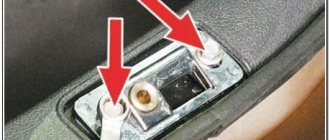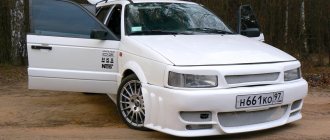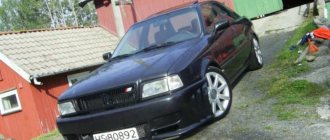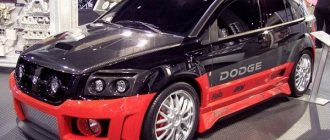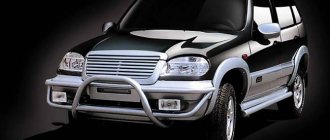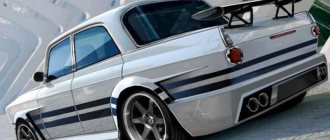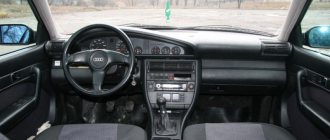Show me your car and I will tell you who you are - the revised saying perfectly reflects the true state of affairs. A four-wheeled friend can tell a lot about its owner. If we consider tuning from a practical point of view, then its direct task is to improve the car. Make it more powerful, more economical, more obedient and more beautiful. With a deeper approach, another important goal appears - to distinguish the car from the crowd of others. And through this, the third point is revealed: tuning is a unique way of self-expression, a guide and exponent of the car owner’s worldview. What will he choose? Sporty chic and racing performance or respectability and comfort? Emphasized brutality or discreet elegance? In any case, tuning allows you to adjust the car to the tastes and requirements of the owner; all that remains is to decide where and how to implement your plans.
Car tuning for beginners where to start
Car tuning is a labor-intensive and very interesting process. Tuning allows you to distinguish a car from the “gray mass” both technically and aesthetically. It often happens that car tuning begins without a preliminary plan, which often ends up stopping halfway. First, let's look at the types of vehicle tuning:
- Chip tuning
- Technical tuning
- External and internal tuning.
The benefits of chip tuning
The main task of this kind of tuning is to increase engine power, resorting only to flashing the engine control unit. This type of tuning can have a positive effect not only on increasing power, but also on reducing fuel consumption, thanks to fine-tuning the ratio of air and gasoline, as well as shifting the ignition angle in one direction or another.
Parts such as a camshaft with different characteristics, fuel injectors with increased performance, direct-flow exhaust system, etc., require the control unit to be reconfigured after installation to different parameters.
Chip tuning has its disadvantages:
- Increased sensitivity of the engine to the quality and octane number of fuel.
- Exhaust gases may not meet emission standards.
- Increased attention to the quality of filling fluids, shorter engine maintenance intervals.
Chip tuning is the first step to improving the technical characteristics of your car, and the most ideal and cheapest option to start tuning. For a small amount of money, with the help of ECU correction, you can increase power by 20% or more.
Technical tuning
In order to properly tune your car, you need to initially calculate your budget and wishes, what exactly will be required from the car. It is important to understand how much power you want to get at the output. With an increase in engine power, you should think about improving the braking system and suspension, as well as the steering.
For example, let's consider a tuning option based on any front-wheel drive VAZ car with an injection engine, the power of which should be suitable for city driving, leaving most cars behind.
Any serious technical tuning begins with the brakes. Brakes are one of the important systems in a car, which is directly responsible for safety on the road. The standard brake system is calculated for the specific weight of the car and its power with some margin. The standard braking system is dangerous for a car whose power has increased even by one and a half times. If you brake very sharply several times, the brake discs overheat greatly, which ultimately increases the braking distance many times, and in extreme cases the car refuses to brake at all.
The first step is to change all the brake discs; it is advisable to install them with an increased diameter and ventilated ones with perforations. You also need to install only the best pads, where the coefficient of friction is very high.
Suspension and steering
- Shock absorbers (gas-oil)
- Hard springs
- Anti-roll bar with increased diameter
- Change all rubber bands and silent blocks to polyurethane
- Ball joints and steering rods are replaced with reinforced ones
Transmission
Transmission tuning will help reduce vehicle acceleration without changing the technical characteristics of the engine. In order to properly prepare the transmission for high power, you will need:
- enhanced clutch (with an increased diameter of the clutch basket and disc);
- the ability to change gear ratios based on wishes. Short passes for the city. Long gears for comfortable and economical driving on the highway;
- installing a differential lock for better wheel engagement at the start, reducing the likelihood of slipping, will also be useful on wet and slippery roads;
- reinforced gearbox housing plate.
Engine tuning
Engine tuning should be done last in a series of technical upgrades. First you need to decide on the engine power in order to properly assemble the brakes and chassis with the transmission. Increasing engine power can be done in different ways, namely:
- Increasing power by increasing cylinder volume;
- Installation of lightweight ShPG and flywheel;
- Increasing the inlet and outlet channels, installing valves with higher throughput;
- Camshafts with different phases and cam lift;
- Significant increase in power using a turbine or compressor (the most expensive tuning);
- Installation of an intake manifold with different characteristics, an enlarged throttle valve, or installation of a 4-throttle intake;
- Nozzles with increased performance;
- Direct-flow exhaust system;
- Correction of the ECU after assembling the tuning motor to set the correct configuration.
Styling and tuning of the interior
- Tinting;
- Replacement of wheel rims;
- Installation of an aerodynamic body kit, which not only gives an aesthetic appearance, but also allows you to reduce the coefficient of air resistance and press the car more to the road;
- Airbrushing or gluing the body with film. In order to come to such a step, you need to understand that it is advisable not to use a car covered with film or with airbrushing every day, and only in good weather in optimal external conditions;
- Installation of tuning optics. Will add appearance when installing body kits;
- The interior can also be modernized to suit your needs and tastes, as well as the size of your wallet, since often tuning the interior space involves upholstering the interior with expensive fabrics, overexposing the dashboard, or applying water prints to individual interior parts.
Car tuning is a pleasant and labor-intensive process where you can realize absolutely any fantasy and turn an ordinary car into the car of your dreams.
buesto › Blog › 7 easiest ways to tune a car
Your friend bought himself a new car and is now cruising the highway, not paying attention to such trifles as fuel consumption. Well, you probably wouldn’t refuse a new “horse” either, but the financial issue put an end to such plans. Life is difficult and the road gives bumps to every bone of your body, once again reminding you of the age of Bucephalus, who, once again, makes a difficult journey through traffic and habitually broken roads, so familiar and so unpleasant. There are no prospects of changing the car, or you are simply accustomed to an old friend - but you can enjoy driving in this case too. Improving torque, traction and other little things can breathe new life into even an older model. No, we're not suggesting you spend all your hard-earned savings on turning your car into a road clown that looks like an escaped extra from Fast and the Furious. No spoilers, body kits, skirts or flames painted on the hood. After all, there are numerous changes that you can make with minimal investment and get maximum results. Here are the seven most accessible methods for tuning a car of any age and any model so that driving it is enjoyable and gas mileage is reduced to a minimum level.
Cold intake system
Installing a Cold Air Intake will give your engine a breath of fresh air—literally. This is perhaps the least expensive way to improve your car's power and efficiency. CAI takes air not from the engine compartment, where after just a few minutes of engine operation it becomes hot as hell, but from the street, increasing the efficiency of hp use. and fuel. It is better to install the system closer to the hood, and not in the grille of a standard air intake, as many do, since this is fraught with the accumulation of moisture in the engine.
Tubular exhaust manifold
The Cold Air Intake system gives the engine more performance - the exhaust system helps score a few more points in this area. A modern car's muffler and catalytic converter exist to reduce noise and emissions, but they also prevent the car from drawing waste gases back into the engine, causing the engine to overheat. Replacing the cast iron exhaust manifold with a ceramic short tubular one will give the engine a significant increase in power.
The engine control unit
Any modern car is equipped with an ECU - an electronic engine control unit. The correct operation of the engine and other systems rests on his shoulders. Reflashing the standard program installed by the manufacturer will help improve the comfort you get from driving. The car will run more smoothly, dynamics will improve, power and torque will also increase. In addition, as a side effect, you may well get a reduction in fuel consumption
You can pack all the power in the universe under the hood, but without good traction, that power will stay there. Instead of installing an all-season kit, or simply not changing your winter tires, make sure your kit is appropriate for the weather outside. The best tires and the right tread pattern not only increase traction, but also control the behavior of your car as a whole.
Spark plug tuning can transform your engine from lazy and power hungry to a real hard worker. The best spark plug materials are iridium and platinum. The diameter of the electrode directly affects the engine parameters. The thinner it is, the less gasoline the engine consumes. Therefore, you should not save money and install regular spark plugs: iridium and platinum will last you much longer.
The devil is in the details - and rubber bushings are one of these small but very important elements of budget tuning. Small, invisible and seemingly insignificant bushings are actually a key factor in how your car handles and feels. Bushings are located in the machine's suspension system, helping to isolate metal parts from each other and reduce damaging vibration. But rubber bushings installed by default have a very limited life expectancy. Especially when they have to come into contact with oils or lubricants heated to extreme temperatures. Replacing the bushings with stiffer, polyurethane ones will lead to an overall improvement in the car's behavior on the road and, of course, will allow you to feel your car better.
The easiest way to increase your power is by installing a zero-resistance air filter. But there are also disadvantages here, because the flow of oxygen into the fuel system will increase significantly. This will also affect fuel consumption, and in the future will reduce the service life of the mass air flow sensor. In addition, along with the air, the engine will receive all the small solid particles that it contains. Such tuning will require you to pay close attention to the contamination of the oil filter, but the increased engine power is definitely worth it.
Other tuning options
Carbon fiber pasting
Carbon is a carbon material with a textured surface. Professionals can use it to change the appearance of your car body or its parts. It is difficult to work with carbon fiber yourself, since the material is too fragile.
Aerodynamic body kits and spoilers
Aerodynamic body kit - made of plastic, fiberglass or metal
an additional detail of the car, giving it a somewhat aggressive look. It also has a practical application - it improves the behavior of the car at speeds exceeding 120 km/h. Usually body kits are attached to the front bumper.
A spoiler is an element used in sports cars to improve aerodynamics. Currently, many car enthusiasts install it as a decorative element. Be careful, the spoiler can reduce the stability and maneuverability of the car.
Airbrush
Drawings on cars. They are carried out by artists who can use an original painting to turn the body of your car into a work of art.
Tuning the engine and other parts
There are craftsmen who modernize the engine in various ways, improving its properties or, for example, welding a second fuel tank for ease of travel. All these changes are closely related to the lifestyle of the car owner, so it is better to consult with tuning specialists to choose the one that is right for you.
Weight reduction
The engine's job is to pull the car forward or backward, transmitting the movement to the chassis through the gearbox. And the heavier the car, the more powerful the engine must be in order to move the entire mass of the equipped vehicle. Therefore, the lighter the car, the easier it is for the engine to pull it. At the same speed, the speed will be several percent higher. Most often, to lighten the weight of the car, the spare wheel is removed, the hood, trunk, fenders and sills are replaced with lightweight ones made of carbon fiber, or the rear seats are dismantled. This way you can gain 100+ kilograms of weight, which gives a small increase in speed.
In addition to lightening the body and interior parts, weight reduction of some engine parts is also practiced. For example, they install a lightweight flywheel that spins faster and reaches maximum speed earlier. Also, to increase power, standard pistons are replaced with forged ones. Not only do they run easier due to their lighter weight, but they are also more reliable than standard ones and can withstand higher temperatures. This is an important parameter if you are going to install a turbine.
How to tune a car?
Russian Prime Minister Dmitry Medvedev signed a document approving the rules of car tuning. The changes will come into force on June 1, and by this time the Ministry of Internal Affairs must prepare regulations that will spell out all the details and set deadlines for completing the procedures. The adopted decision will simplify state supervision of such vehicles and will make the entire process of making changes to the design of vehicles transparent and understandable.
Previously, there was no prescribed procedure for carrying out and registering tuning. This resulted in motorists not registering changes made and receiving severe fines for even minimal improvements. The hardest thing was for off-road enthusiasts and those who converted their cars to gas engine fuel: neither the drivers themselves nor the traffic police officers always understood how to register such cars. Experts believe that now the process has become, if not simpler, then at least more logical. Let's figure out what has changed.
Changes to the design of the vehicle can be made after obtaining the appropriate permission from the State Traffic Inspectorate. During the first visit to the traffic police, there is no need to bring a car that is planned to be retrofitted and improved.
The driver must first draw up a work plan and submit it to a certified testing laboratory or specialized technical center. The document must specify what exactly is planned to be changed in the design of the vehicle. Based on these data, experts will assess the possibility of such changes. A positive decision is possible only if “the car retains its properties and does not cease to meet safety requirements.”
The conclusion of the preliminary technical examination is signed by the expert, as well as by the head of the testing laboratory and certified by the seal of the organization. The conclusion, in addition to detailed information about the laboratory, must contain the date and number of the conclusion, information about the make, model, state registration plate, type of vehicle, identification number or chassis (frame) and body number, environmental class, model, engine type and power — in general, all available technical information about the car. This document must first be submitted to the traffic police.
The traffic police will not agree to issue a permit for tuning if experts decide that the changes made to the design will be unsafe and contrary to technical requirements. Therefore, it is important to first study the documents and conclusions obtained on your own.
If everything is in order, you should take the conclusion of the preliminary technical examination to the traffic police. Along with it, the vehicle owner must provide an application for a tuning permit and a passport. Documents can also be submitted by another person with a power of attorney. After which the traffic police begin to study the documents. If no questions arise, the department issues permission for the requested changes.
The traffic police may reject an application if registration documents or state registration plates are wanted or a ban or restriction on registration actions has been imposed on the vehicle. A motorist may be refused if the documents provided are incomplete or they show signs of falsification, as well as if the reputation of the laboratory is in doubt.
Turbine installation
One of the most expensive and difficult ways to add engine power. But the turbine will give a significant increase. Most often, turbines are installed that direct air flow into the intake manifold. This gives a significant increase in power when running on gas. But if you want the maximum increase in power, then you should choose centrifugal turbochargers.
The essence of this device is that centrifugal forces rotate the impeller at a very high speed. Large flows of oxygen are sucked into the engine, which increases its power. Keep in mind that such powerful turbines are installed on reliable engines, most often diesel engines, which have cast iron cylinders that can withstand high temperatures and heavy loads.
Types of car tuning (pros and cons)
The translation of the English word Tuning (tuning, adjustment) does not fully describe the direction of the automotive business (or rather the automotive world) called car tuning. Refining the design, changing operating modes at the software level, changing the external design and interior - this is not a complete list of what is included in the concept of tuning.
Why is auto tuning needed, and what types does it come in? Is it possible to “tune” your car yourself? What qualifications are needed for this, and what could be the consequences of mistakes? How does tuning affect the value of a car during its subsequent resale? The answers to these and other questions are of interest to a wide range of owners of both premium and budget cars.
What is car tuning and why is it needed?
Contrary to the popular belief that auto tuning as a phenomenon appeared relatively recently, the first work in this direction began at the beginning of the last century - almost immediately with the serial production of the first passenger cars. This is understandable, a car is not a cheap product and the first car owners sought to emphasize the individuality of their car.
In this regard, little has changed over the past century - it is the desire for individuality that pushes car enthusiasts to change the external and internal appearance of the car and its technical (mostly functional) characteristics.
And if just recently car tuning was the lot of a young audience, now it is increasingly shifting towards sensible middle age. After all, optimization of car maintenance costs may be a consequence of additional changes in the factory design or changes in engine control programs aimed at optimizing the car’s characteristics. For example, measures aimed at reducing fuel consumption in certain driving modes.
Tuning may also involve a significant expansion of the capabilities of factory car models, associated not with a sharp increase in engine power and acceleration dynamics, but with improved cross-country ability, duplication of vital systems, and increased survivability in hard-to-reach and sparsely populated areas.
For certain groups of car owners, the unique appearance and unique interior decoration of a car, even if it is very expensive as standard, is fundamentally important. Others are interested in turning the car into an infotainment center, stuffed with audio and video equipment.
So in its most general form, tuning is any activity related to changing the design, design and/or standard settings, adjustments or software of production cars.
Advantages and disadvantages of auto tuning
Without a doubt, tuning is a very interesting and exciting activity. Owners of tuned cars highlight the following advantages:
- Whether the car owner does the tuning himself or uses the services of professionals, he receives a car with pronounced individual features and improved performance.
- Almost always, tuning becomes a hobby (and sometimes a lifestyle) for a car enthusiast, his horizons expand, and new interesting facets appear in life.
- A new circle of acquaintances appears among others who are passionate about tuning people.
However, those who have decided to start tuning their own car for the first time should remember that they must carefully weigh their capabilities with the understanding that for little money without proper training and qualifications you can get a very modest and sometimes disastrous result.
The most common illustration of this is engine chip tuning. Of course, from such an operation you want everything at once: increased engine power, reduced fuel consumption, and even increased torque. But even car owners who are little familiar with technology understand (perhaps not immediately) that this does not happen, and improvement in some parameters, as a rule, comes at the expense of deterioration in others.
By the way, reprogramming the electronic engine control unit gives noticeable results (up to 20% increase in power) only on turbocharged engines.
In this case, the work must be performed by a qualified specialist using software developed by the same car manufacturer. Otherwise, there are no guarantees that the changes made will not lead to unacceptable loads, both in the engine itself and in the systems associated with it (clutch, gearbox, chassis). And guaranteed quality work cannot be cheap.
The main disadvantage of any tuning is its often negative impact on the value of the car upon subsequent resale. Of course, there are cases when thoughtful and well-executed tuning even slightly increases the cost of the car, but the vast majority of buyers on the secondary market prefer the serial version, which was used in non-aggressive driving conditions.
And in this situation, the only option left is to “tuner” the car to production condition. By the way, in the West, bringing a car to its initial state is also considered one of the areas of tuning.
conclusions
Most of the work on upgrading a car can be done with your own hands at home. This applies to modifications to the interior and body of the car. In order to do everything, you need very little: imagination, time and desire to do something, as well as simple skills in working with the tool. Doing tuning yourself is not only interesting and exciting, but also more economical than if you went to a car repair shop. However, if you decide to finalize the technical parameters of the machine, then, of course, it is better not to take risks, but to entrust everything to professionals.
